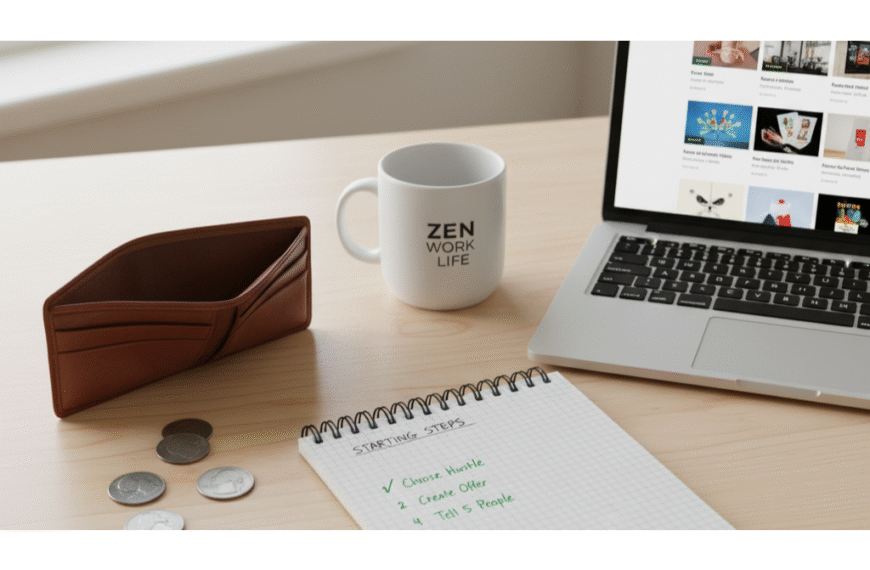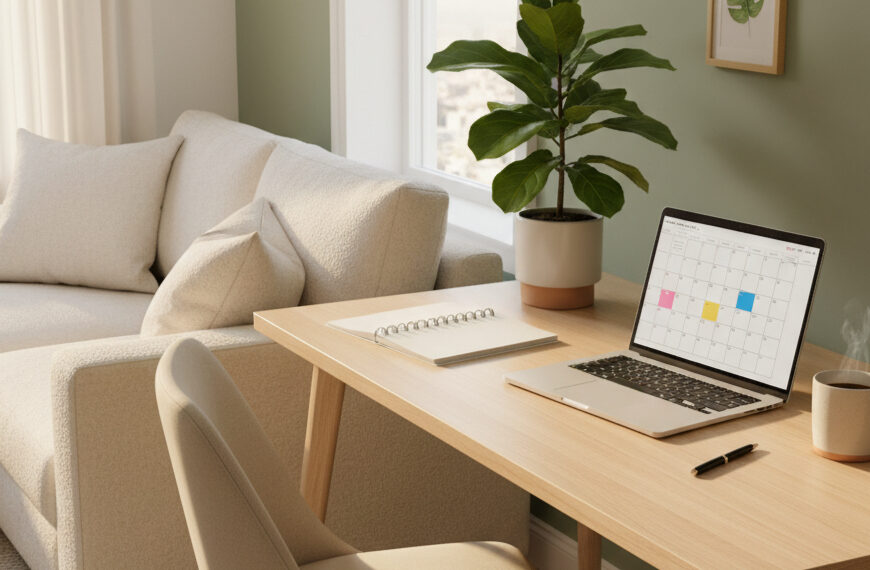Let’s be honest: “self-care” can feel like just another item on an endless to-do list.
When you’re juggling a 9-to-5, building a side hustle, and trying to achieve financial freedom, the idea of a two-hour bubble bath or a weekend yoga retreat sounds… well, impossible. We’re part of a culture that glorifies the “grind,” where being busy is a badge of honor and burnout is just the cost of admission.
I’ve been there. I’ve had weeks fueled by nothing but caffeine and deadlines, where “lunch” was a protein bar eaten while typing. And I’ve learned the hard way that you can’t build a sustainable future on an empty tank. Burnout doesn’t just feel bad; it’s the ultimate dream-killer. It’s the enemy of productivity, creativity, and, yes, your financial goals.
But what if self-care wasn’t about adding more to your plate, but about strategically recharging between the big tasks?This article isn’t about expensive spa days. It’s about simple self-care ideas for busy professionals—practical, fast, and effective ways to recharge your battery so you can keep showing up for your goals.
Why “Hustle Culture” Is a Trap (And Why Self-Care Isn’t Selfish)
I used to think that any minute I wasn’t “working” was a minute wasted. I saw self-care as an indulgence, something I’d earn after I hit my next big milestone.
The problem? The milestones kept moving, and I was getting closer and closer to a total crash.
In 2025, we’re all hyper-aware of burnout. It’s not just a buzzword; it’s a real occupational phenomenon. The World Health Organization (WHO) has officially recognized it, linking it to chronic workplace stress.
Here’s the thing: self-care isn’t selfish. It’s essential maintenance.
You wouldn’t drive your car for 50,000 miles without an oil change, right? You’d end up stranded on the side of the road with a blown engine. Your brain and body are no different. Pushing them to the limit 24/7 without a break leads to the same result.
For busy professionals, self-care is a productivity tool. It’s what clears the mental fog, boosts creativity, and gives you the long-term endurance to outlast the “grinders” who burn out by 30.
The 5-Minute Reset: Reclaiming Your Day in Micro-Doses
When you only have 30 minutes for lunch, an hour-long break is a fantasy. But anyone can find five minutes. The “micro-break” has become my secret weapon.
It’s about intentionally scheduling small, restorative pauses between your high-focus tasks. When I first tried this, I made the mistake of using that “break” to check social media or read emails—which isn’t a break at all. It’s just a different kind of work.
True micro-breaks are about disconnecting. Here are a few 5-minute ideas:
- The “Sky” Break: Stand up, walk to the nearest window, and just look at the sky for 60 seconds. Don’t check your phone. Just watch the clouds. It helps reset your focus.
- Mindful Hydration: Get up, walk to the kitchen, and pour yourself a glass of water. Drink it slowly and deliberately, focusing only on that task.
- The 60-Second Stretch: You don’t need a full yoga routine. Just stand up, reach your hands to the sky, and do a simple side-body stretch. (More on this later).
✨ Quick Win: Try the 4-7-8 breathing technique. Inhale for 4 seconds, hold your breath for 7 seconds, and exhale slowly for 8 seconds. Do this three times. It takes less than two minutes and can instantly lower your heart rate before a big meeting.
“Tech-Free” Time: Simple Self-Care Ideas for Your Digital Brain
As remote workers and freelancers, our screens are our offices, our social spaces, and our entertainment. We’re always on. This constant digital “noise” is exhausting.
One of the most effective simple self-care ideas for busy professionals is creating small, tech-free zones in your day.
In 2025, I’ve noticed more and more people talking about “digital fatigue.” We’re wired and tired. The solution is to create digital boundaries.
- No Phone for the First 20: For the first 20 minutes after you wake up, don’t look at your phone. No email, no news, no social media. Let your brain boot up before you flood it with notifications. I use this time to hydrate, stretch, or just sit with my coffee.
- The “Fake Commute”: This is a lifesaver for remote workers. When you’re “done” for the day, don’t just move from the desk to the couch. Put on your shoes and walk around the block for 10 minutes. It creates a physical and mental separation between “work” and “home.”

Fuel Your Hustle: Self-Care You Can Eat (and Drink)
Let me be honest. When I get deep into a project, my diet is the first thing to go. I’ll forget to eat, then suddenly realize I’m starving and grab the fastest, easiest thing (which is rarely the healthiest).
Sound familiar?
Self-care you can eat isn’t about a restrictive diet. It’s about giving your brain the basic fuel it needs to function.
Idea #4: The Hydration-Productivity Link This is the simplest self-care act in the world: drink more water. Even mild dehydration can mess with your mood, concentration, and energy levels. According to the Mayo Clinic, it can cause fatigue and confusion. That “brain fog” you feel at 3 PM? It might just be thirst.
Idea #5: Smart Snacking This isn’t about kale chips (unless you’re into that). It’s about not running on sugary snacks that lead to an energy crash. I keep almonds, an apple, or a protein bar right on my desk. It stops me from getting “hangry” and losing an hour of productivity.
💡 Pro Tip: Get a 1-liter water bottle and put it on your desk. My goal is simple: drink one full bottle by lunch and another one by the end of the workday. It makes tracking water intake automatic.
Move Your Body, Even When You’re Chained to a Desk
When I hear “exercise,” my mind jumps to my full Push/Pull/Legs gym routine. But on a 12-hour workday, that’s not happening.
The “all or nothing” mindset is a trap. If we can’t do the “perfect” workout, we do nothing. Instead, aim for “movement snacks.”
We sit a lot. A 2024 Gallup poll found that employee stress is at a record high, and a sedentary work life doesn’t help. “Movement snacks” are 2-10 minute bursts of activity to break up the sitting.
Idea #6: The Desk-Chair Stretch Set a timer for every 60 minutes. When it goes off, stand up and do these:
- Neck Rolls: Gently roll your head from side to side.
- Shoulder Shrugs: Pull your shoulders up to your ears, hold, and release.
- Torso Twists: Sit tall and gently twist your upper body left and right.
Idea #7: The “Waiting” Workout Waiting for the coffee to brew? Do 10 squats. Waiting for a file to download? Do 10 wall push-ups. It sounds silly, but these little bursts add up. They get your blood flowing and break the physical monotony of desk work.
The Power of “No”: Boundaries as the Ultimate Self-Care
This is the hardest one for ambitious people. We want to say “yes”—to new projects, to more clients, to that side hustle idea. We’re afraid of missing an opportunity.
But here’s a lesson I had to learn: Every “yes” is a “no” to something else.
A “yes” to a last-minute project is a “no” to your evening wind-down. A “yes” to a meeting you don’t need to be in is a “no” to an hour of deep work.
Idea #8: The “Polite No” You don’t have to be a jerk. A simple, “I don’t have the bandwidth to give that the attention it deserves right now” is powerful. It’s not “I can’t”; it’s “I’m prioritizing.”
Idea #9: Time-Blocking Your “Off” Time Schedule your breaks. Put “Lunch” on your calendar. Block out “End of Day” at 6 PM. Treat your personal time with the same respect you treat a client meeting. This is the single best way to protect your work-life balance.
⚠️ Watch Out: Don’t confuse “self-care” with “toxic positivity.” Real self-care isn’t about pretending everything is fine. It’s about acknowledging you’re stressed or tired and then doing something constructive about it—like setting a boundary or taking a real break.
Your Wind-Down Ritual: How to Actually Log Off
My biggest mistake for years was working until the moment I went to bed. I’d close my laptop, brush my teeth, and get under the covers, my brain still processing code or drafting blog posts. Then I’d wonder why I couldn’t sleep.
You can’t just slam the brakes on your brain. You need a buffer.
Idea #10: The “Shutdown Ritual” This is the last 15-20 minutes of your workday. It’s a simple routine that signals to your brain that the day is over. My ritual is:
- Review: Look at my calendar for tomorrow.
- List: Write down my Top 3 priorities for the next day. This gets them out of my head so I’m not stressing about them.
- Close: Close all tabs. All of them.
- Tidy: Wipe down my desk and put my notebook away.
When I do this, I’m mentally “clocking out.” After this, work is done. I don’t check email. I don’t “just quickly” finish one more thing.
This simple routine has been a game-changer for my mental health, allowing me to be fully present in my non-work life, which in turn makes me more refreshed and creative the next day.
Conclusion
Self-care isn’t another mountain to climb. It’s the gear that helps you make the journey.
For busy professionals like us, who are chasing big goals of financial freedom and a life by design, burnout is the greatest threat. These simple self-care ideas aren’t about luxury; they’re about longevity.
You don’t have to do all 10 of these at once. That’s just a new to-do list, which is the opposite of the goal.
Here’s your challenge: Pick one.
Just one. Maybe it’s the 5-minute breathing exercise. Maybe it’s committing to a “shutdown ritual” tonight. Start small, stay consistent, and watch how it changes your energy. Remember, you’re your business’s most important asset. Treat yourself like one.
What’s your biggest challenge with self-care? Or what’s one simple tip that works for you? Share it in the comments below!
Frequently Asked Questions (FAQ)
Q: What’s the difference between self-care and just being lazy or indulgent? A: It’s all about intent. Indulgence is often about seeking pleasure to escape a problem (like binge-watching TV to avoid a deadline). Self-care is about restorative action. It’s productive maintenance—like sleep, healthy food, or setting boundaries—that refuels you so you can continue to perform at your best.
Q: How can I practice self-care when I literally have zero free time? A: Redefine “time.” You don’t need an hour. You have 60 seconds. You can practice self-care while doing other things. Sipping water mindfully is self-care. Stretching for 30 seconds while your computer boots up is self-care. It’s about integrating micro-moments of restoration, not scheduling another huge block.Q: I feel guilty when I take a break. How do I get over that? A: This is so common. It’s “hustle culture” guilt. Reframe it logically: A tired, burnt-out brain produces slow, low-quality work. A rested, recharged brain produces fast, high-quality work. Taking a 10-minute break might save you an hour of frustrated, unproductive effort. Your breaks are an investment in your own productivity.



